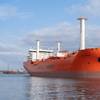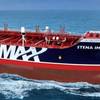Hundreds of people desperate to be rescued from a packed migrant boat in the Mediterranean pushed to one side when they saw a ship approach, capsizing the craft and pitching everyone into the sea where hundreds died, an official said on Wednesday.
Survivors' accounts suggested at least 500 people were on the boat when it sank on Monday evening, some 120 km (75 miles) off the Italian island of Lampedusa. With 145 people rescued that leaves at least 350 unaccounted for, probably drowned.
Joel Millman, spokesman for the International Organization for Migration (IOM), said: "According to testimonies, at least one-third of the passengers were women and children. At the time of the shipwreck, they were staying in the hull of the boat to be better protected from the cold.
"When the men on the deck became restless and started moving about because a rescue boat was beginning to approach them, the boat capsized and water flooded the hull. Women and children died immediately."
Monday's incident would bring the total number of dead on migrant boats in the Mediterranean since January to around 900 amid a surge in would-be immigrants to Europe after the breakdown of order in Libya created fertile conditions for human traffickers.
With fine weather encouraging more boats to leave, the Italian Coast Guard said almost 10,000 boat people had been rescued since the weekend, with 1,511 picked up in 12 separate operations on Tuesday alone.
Italy ended its "Mare Nostrum" maritime rescue mission last year following heavy pressure from anti-immigrant parties. A smaller European Union border protection operation, Triton, that replaced it has struggled to cope.
"Unfortunately Mare Nostrum was never replaced by an equivalent capacity to rescue people," said UN High Commissioner for Refugees António Guterres, calling for a more robust search-and-rescue mission to be set up in the Mediterranean.
The number of migrants and deaths could exceed even last year's total when 219,000 people crossed the Mediterranean and at least 3,500 lives were lost, according to the United Nations High Commissioner for Refugees.
So far in 2015, around 31,500 people are known to have made crossings to Italy and Greece, the number one and number two countries of arrival but numbers usually peak in the summer months when sailing conditions are easier.
(By Stephanie Nebehay; Writing by James Mackenzie in Rome; Editing by Robin Pomeroy)













